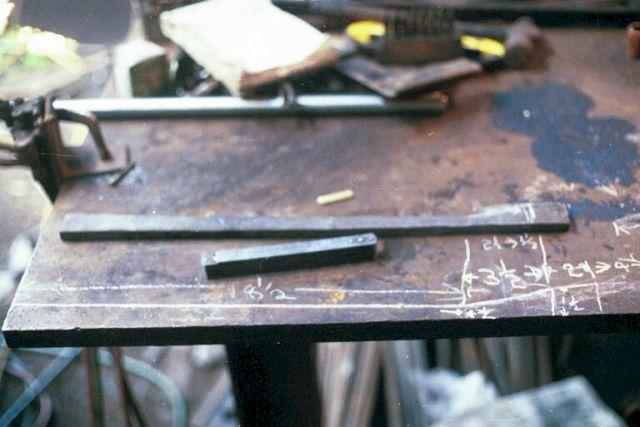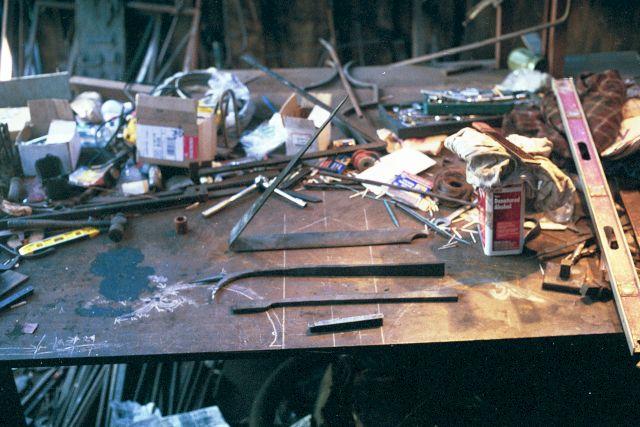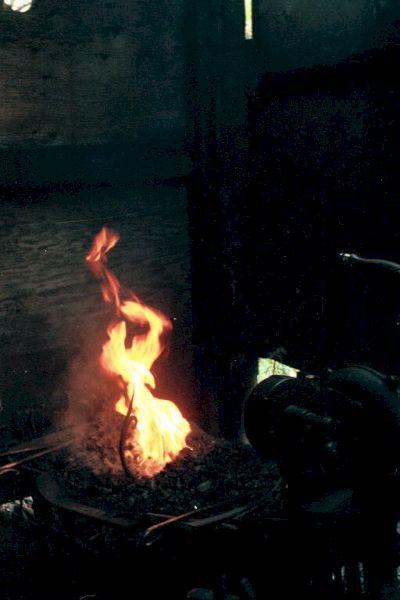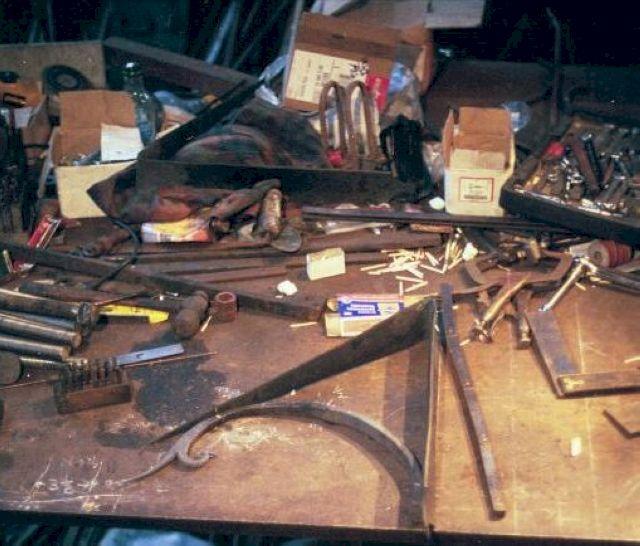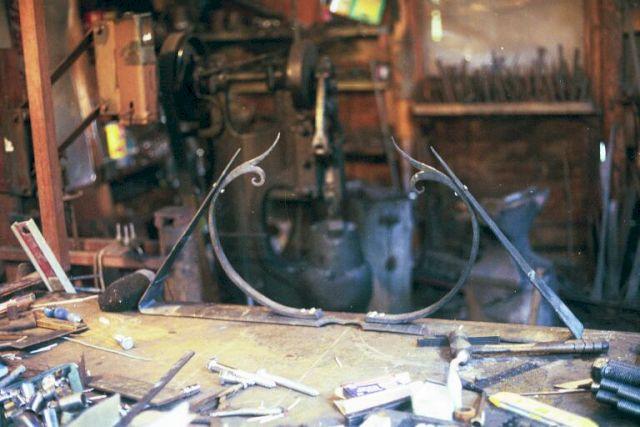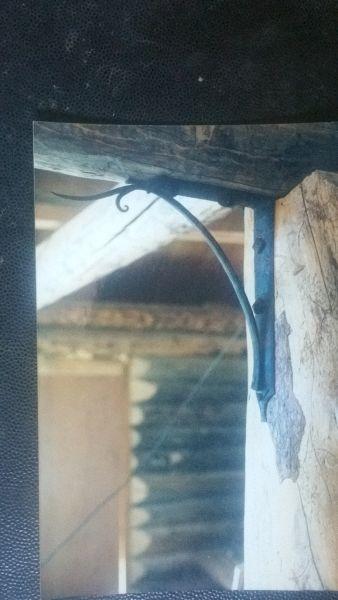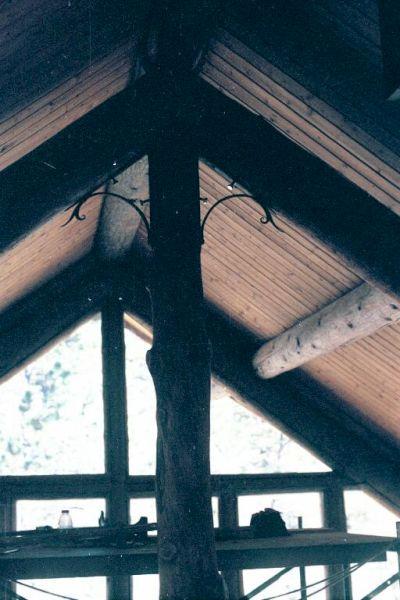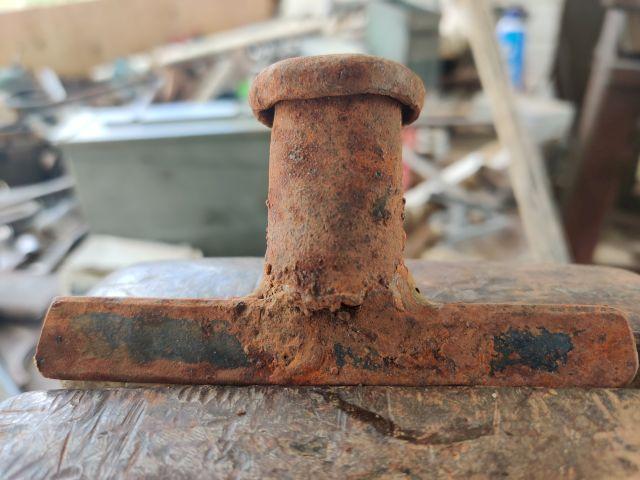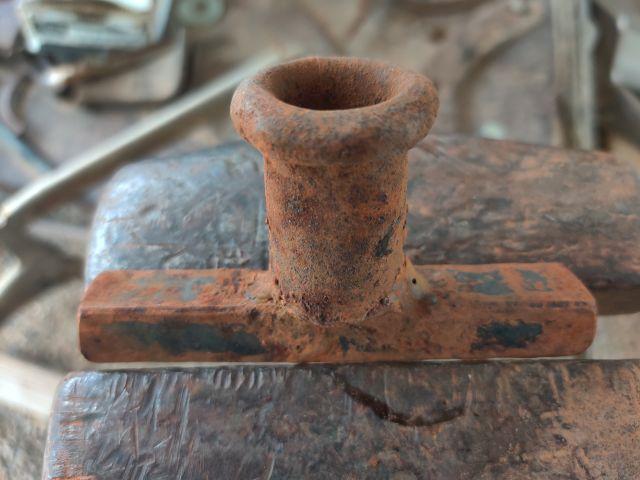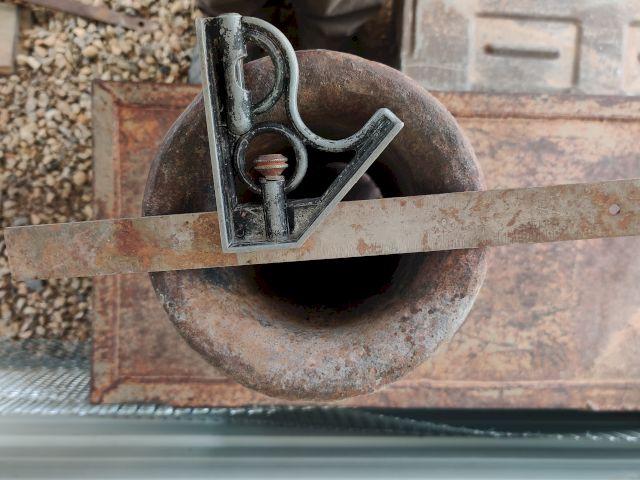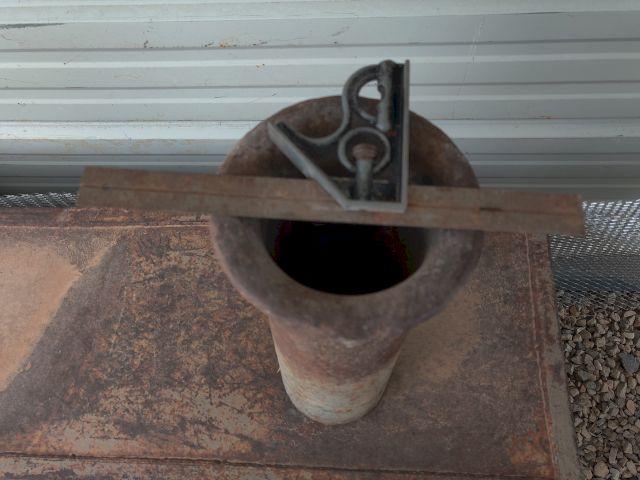-
Posts
3,246 -
Joined
-
Last visited
Content Type
Profiles
Forums
Articles
Gallery
Downloads
Events
Everything posted by anvil
-
Lol, my answer to your question is nope. And like Thomas said, find one that fits your needs. I'm a London pattern kind of a guy. I've used double horn'd anvils in other shops and am comfortable with them as well as a few make do types over the years. For my needs, I prefer the parallel sides of the heel. Notice in the pic above of Thomas,,, thats a Thomas style stick welder because hes just so charged as a blacksmith,,, I'm sure he found this design somewhere in his library.
-

Any good hand creams to reccomend?
anvil replied to Mr. Freshman's topic in Blacksmithing, General Discussion
Altho it hasn't been mentioned, when you do get those pesky cuts, the aloe plant rules! -
Cool. learning how to make most anything over the edge of the anvil before using a jig or a die is the best way.
-

Blacksmiths making a living in today,s market?
anvil replied to Fly's topic in The Business Side of Blacksmithing
I've been a working smith since '80. I got there via being a Farrier for about 18 years with the intent of becoming a working smith, the difference being a working smith doesn't have to bend over to make money. For the last few years I consider that I am semi retired. Old horse shoers do fewer and fewer horses and old smiths work smaller and smaller iron. It is not easy, but very possible and the life is great. If you are starting out cold, the first catch 22 is money. Most banks won't lend money on a nitch business. My one liner here is there are two ways to make it work: Be financially independent or independently wealthy. The latter means somewhere in your existence there is someone who can finance you. A wife works,,,,, lol,,, The former, financially independent, means ya just don't need much money to live on,,, My way was a combination of both, a supportive wife, paid off property, and a lifestyle that I like to say was all those things John Denver never sang about, and it worked. What to make, or what direction will work in this day and age? First, I thank our lucky stars that the industrial revolution happened. It took away all those needed and very tedious jobs that a modern society needs and it left we smiths of the day the Creme-de-la-Creme which is baring knife work, shoeing, and industrial smithing, Architectural Smithing. This is a very broad category that covers anything from "S" hooks for hanging plants to those beautiful gates, chandeliers and railings. My first "commission" was a few brackets for a small cabin for a builder/developer. They were heavy angle iron hand hacksawed to length, my first curved hot cut to cut the bottom corners, and a very crude champfered edge. I posted some pics the other day of some I've made more recently. I've come along way! Brackets are an unsung product that can be made and priced competitively with production and, no matter how simple and crude, there is a pretty good market and a great intro and unique product. The main trap, in my opinion, is drop the idea that you should be able to make a living right out the door. If you hold this business principal close, you will increase your chances of failure immensely. There is a good reason why there was, more or less, a 7 year apprenticeship plus a number of years as a journeymanship. I could go on, but these hints cover a lot of ground. Enjoy -

Wedge and feathers for splitting stone?
anvil replied to melonkernel's topic in Blacksmithing, General Discussion
-

Wedge and feathers for splitting stone?
anvil replied to melonkernel's topic in Blacksmithing, General Discussion
What a memory from the past! I remember that song and played it on my guitar! -
Heres my solution to a too small stump. I have an alaskan mill for my chainsaw, but its not needed. 3 cuts on the log, a handfull of all thread,some hand forged washers, buried into the ground, and the anvil notched into the top of the log. It even held a couple inches of fine sand to set my anvil into. No exterior fittings needed to hold the anvil firmly into place. Lol, it has the added feature of a cool shape. I don't usually hang too much stuff on the stump, but there is plenty of room on the two flat surfaces. And no plane needed.
-

Any good hand creams to reccomend?
anvil replied to Mr. Freshman's topic in Blacksmithing, General Discussion
I've been a fan of Bag Balm since my farrier daze -
If it wont fall over and there is no vibration to take your force you are good. For me I want my anvil face level.
-
Sorry to hear that, You are in my prayers
-
Beyond safety, you will have a lot of energy loss to vibration. For me, the most critical deal is having the anvil securly attached to the stand and the stand securely attached to the ground. If your anvil moves on the stump, there is a loss of force. Same goes for the stump to ground. It looks looks you have a dirt forge. I'd consider a single piece stump and bury it about 2' in the ground and tamp it well. I've found that if you chisel your anvil into the stump with a tight fit and deep enough to put a couple inches in, your anvil is easy to level and the sand helps to deaden the sound.
-
I have the narrow end of the firepot in front of me. The clinker ball handle should be below you and in front of you, not to the side. If your electric is grounded, you shouldn't have a problem. However, shutting off the electric is not a bad idea,,, just in case.
-

Wedge and feathers for splitting stone?
anvil replied to melonkernel's topic in Blacksmithing, General Discussion
I've made and used feathers and wedges. Mild steel is fine. If you use them enough that you need to dress them,,, lo9l, you are really working! Coil spring works well and is cheap. About the best reason I can think of for heat treating them is it will give you experience heat treating. Do a little research into some of the old ~1900 blacksmithing books that were used as text in schools. They have some great info on what colors you should run for specific applications. "Plane and Ornamental Forging" by Ernst Schwarzkopf is readily available and can be found via google. Never used any lube, so I can't answer that -
Yep. without a doubt fire clay is your answer. Clay just won't hold up. Clay and bentonite? The clay still won't hold up.
-
I think the answer to your question is to use fire clay. You can use it ovver the dirt, or just use fire clay.
-
Another random sign,,, There have been an increasing number of posts on the willys restoration sites for converting to electric. Hope this isn't political, its not meant that way. The remainder of this comment crossed the line into political discussion and has been removed.
-
I made this statement above and feel it is important enough to expand on it a bit. This twist is a technique and too often when we learn one, we don't apply it to other ideas or designs. These hinges were for a log house, and I chose to fit them to the log, including each log joint because I wanted the brackets to be what I call a negative detail. Positive means it stands out and is the most common. neutral means all details live together equally and negative means,basically, you don't notice it but if its removed, you feel a sense that somethings missing. It's the most subtle and, the hardest to pull off. Usually in log construction the logs are blazed to give a white background to make the iron stand out, to create a more "factory" right angle and flat spaces for the vert and horiz elements to rest on. Not to mention faster and easier for production type construction's benefit. The "right angle" of the brackets have the angle forged to match the natural log being a curved and unique angle made by the log joinery instead of a straight line. The legs, top and bottom are curved to match the "round" log as well as fitted in and out and twisted in order to fit the character of the log. The first pic is layout. With this chalk layout, each forged piece will match the one shown here. pic 2: shows the drawing of the scroll. The bottom piece shows the right side drawn out, and the left side in its basic untwisted state. The center iron shows the left side finish forged, but not scrolled. You can see the left side is horizontal and the right side is vertical and the twist is forged out. The extra growth from forging the twist out is taken into consideration in my layout. The process here is exactly the same as in the Dempsey Twist. A fuller to separate the two masses, then simple forging to fit whatever you are making. pic 3: Coming out of the fire. pic 4: shows the finished pieces and the final fit before assembly. pic 5: does two things. It is fun play for future ideas and shows how similar both pair of scrolls are. This is most important in the grand scheme of things. The last two pics show them installed and a second variation. So the main deal here is this scroll pattern, with the log part removed is nothing complex and any student with a week or so in the fire should be able to do this if you want some variety in your simple bracket scrolls. For what its worth the log work and joinery is mine as well, done with two good log guys. Enjoy
-
about time you put up some pics,,, Looks Good!
-

leaf forming tool
anvil replied to Duckkisser's topic in Hot Cuts, Anvil devils, metal cutting on the anvil.
I don't believe I said either fast or production is bad. Especially when taken so far out of context. And I think you are using "production" where what you are talking about has to do with efficiency. Most important, We are talking tools, not setup. Apparently you believe there is no difference between production and one off commission. If not, how about speaking of those techniques and how some techniques work well for both, and some are better used for one or the other. Then we will be on the same topic. Then this topic will be of value to far more people here who may want to be familiar with the pro's and cons of their use for either direction they may want to pursue. I find it rather sad that with all your decades of experience, all your advice given, all the projects you have spoken of, classes taught, and tooling made, I have never seen any pics. Neither work in progress, completed, or tooling made and used to complete your work. That leaf tool above is rude and crude and the first hardy I ever made. It served me well. I haven't used it in decades, and yet, even in my eternally limited shop space, I still have it. And yet, you made a leaf jig to get a raised vein that was really complex with a major time investment in it to get just what you needed for an apparently a one off leaf shape.,,, and it went into your scrap pile. Different strokes for different folks, I guess -
Perhaps better said,,, When its yellow its mellow. When its red its dead. Get it hot!
-

leaf forming tool
anvil replied to Duckkisser's topic in Hot Cuts, Anvil devils, metal cutting on the anvil.
I'd like to see your tools and the finished leaf, It sounds pretty cool! As for "faster", Faster is needed in a fab shop, but a job killer when doing commission work. And the opposite is true in a fab shop. Speed is king and detail is a job killer for production. Thats why I said jigs have their place. Another way of looking at that(another one liner so beware) is fab/production is based on dollars per finished foot whilst commission work is based on dollars per finished oz. And that very principal is the reason contemporary construction generally refuses to deal with craftsmen. They expect the crafts to work under the same principal as the trades. Most are too narrow sighted to realize that this is not a problem if the crafts are part of the crew and start their work early in the job. Alas, quality in contemporary construction too often means a black walnut photo veneer glued to chipboard sells for 4-5 times what a photo veneer of rough cut pine glued to the same chipboard will cost. I decided a long time ago that was not the racket I wanted to be in. Don't jump to the conclusion that I believe the crafts are being shorted and production is inferior, thats just not the case. In our age of industrialization, production is the bread and butter, whilst the crafts have evolved into the creme-de-la-creme. I am so glad that production has taken over making "spoons". I would hate to be a pre-industrial blacksmith working in a spoon factory having a 100 spoon per day quota,,, for ever,,, See what I mean by speed is situational? -
Heres some pics One of my small ones and one of my big ones. I prefer, tho not always, to sink into a form than over a stake. These actually work as both. For say a drip pan, you can sink it to please, then roll the outside edges around the top of the die.Both have their place. Use a top tool to fit the job. The size of the bottom tool just determines the chord, not its final shape. For instance, in my large one I have used my cross peen to get flat surfaces within a rounded top. The good thing about rust in a blacksmith shop is it goes away with the first reuse.
-
Lol, I'd prolly take the wall down, then drill the hole precise, then put the wall back up.

